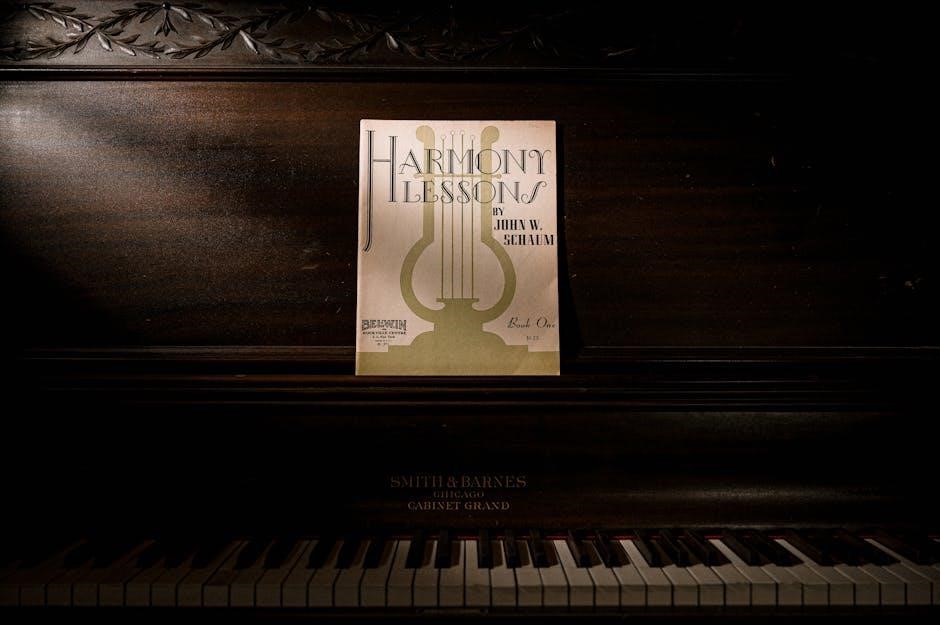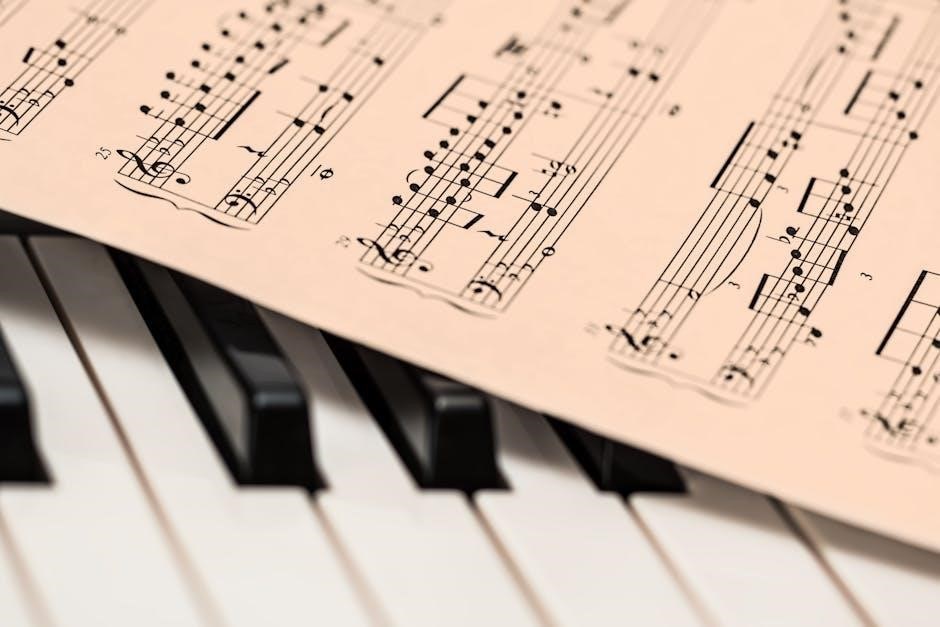Printable piano keyboard PDFs offer a versatile tool for learning and teaching music. These templates provide a visual representation of piano keys, helping users understand note names, layout, and finger placement. Ideal for students, teachers, and musicians, they simplify music theory concepts and practice. Cost-effective and easy to use, printable piano keyboards are a valuable resource for anyone looking to enhance their musical skills.

What is a Printable Piano Keyboard PDF?
A printable piano keyboard PDF is a digital file designed to be downloaded and printed, featuring a visual representation of a piano keyboard. These PDFs often include templates with or without note labels, catering to different learning needs. They can be blank for labeling exercises or pre-labeled for quick reference. Printable piano keyboards are ideal for music students, teachers, and enthusiasts, offering a cost-effective way to practice note recognition, hand positioning, and music theory. Available in various formats, such as full-size or miniature layouts, they provide flexibility for educational or creative projects. Their versatility makes them a popular resource for both beginners and experienced musicians.
Why Use a Printable Piano Keyboard?
Printable piano keyboards are a cost-effective and versatile tool for music learning and practice. They provide a convenient way to visualize the piano layout, making it easier to understand note positions and finger placement. For beginners, these templates help in memorizing key names and their locations. Teachers can use them to create interactive lessons or exercises for students. Additionally, printable keyboards are ideal for musicians who need a quick reference or practice aid without access to a physical piano. Their portability and ease of use make them a valuable resource for anyone looking to enhance their musical skills. They also serve as a creative tool for crafting custom exercises or visual aids for music theory lessons.
Benefits for Piano Students and Teachers
Printable piano keyboard PDFs offer significant benefits for both students and educators. For students, they provide a clear visual guide to understanding note names, key locations, and hand positions. This aids in improving sight-reading skills and memorization. Teachers can utilize these templates to create engaging lessons, quizzes, or exercises tailored to individual or group needs. The ability to label keys or add notes makes them an excellent tool for interactive learning. Additionally, printable keyboards allow students to practice without needing physical access to a piano, making them ideal for homework or travel. They also enable teachers to demonstrate complex concepts, such as chord structures or scales, in a simplified manner. Overall, these resources enhance learning efficiency and make music education more accessible and enjoyable for everyone involved.

Where to Find Printable Piano Keyboard PDFs
Printable piano keyboard PDFs are widely available on online platforms, educational websites, and music resources, offering easy access for various learning and teaching needs.
Free Resources for Download
Several websites offer free printable piano keyboard PDFs, ideal for beginners and educators. Platforms like Musicnotes and Piano Nanny provide downloadable templates. These resources often include labeled keys, making them perfect for teaching music theory. While they may lack advanced features found in premium versions, they are excellent for basic learning. Teachers can use these to create handouts for their students. Additionally, forums and educational blogs frequently share free piano keyboard PDFs tailored for specific lessons. These free resources are a great starting point for anyone looking to explore piano playing without initial investment. They are versatile and easy to print, catering to various learning needs.
Premium Sources for High-Quality Templates
Premium sources offer high-quality printable piano keyboard PDFs with advanced features and professional designs. Websites like Etsy and specialized music stores provide customizable templates with intricate details. These templates often include adjustable layouts, color-coded keys, and interactive elements. Companies like Musicnotes and Sheet Music Plus cater to educators and professionals, offering precise scaling and alignment. Premium templates are ideal for creating durable teaching tools or practice aids. While they require a purchase, they deliver superior quality and versatility, making them a worthwhile investment for serious learners and educators seeking polished materials. These sources ensure that users receive well-designed, professional-grade piano keyboard PDFs tailored to specific needs.
Recommended Websites for Piano Keyboard PDFs
Several websites are highly recommended for downloading printable piano keyboard PDFs. Teachers Pay Teachers offers a variety of educational resources, including customizable piano keyboards. Musicnotes provides high-quality, printable templates designed for both students and educators. Additionally, Piano Nanny and Piano Marvel are excellent sources for interactive and visually appealing piano keyboard layouts. These websites cater to different skill levels and preferences, ensuring users find the perfect template for their needs. Whether you’re a teacher or a learner, these platforms are reliable and offer easy-to-download formats. Explore these sites to find the ideal piano keyboard PDF for your musical journey.

Design and Layout of Printable Piano Keyboards
Printable piano keyboards are available in various designs, including blank, labeled, and color-coded layouts. They can be full-size or miniature, catering to different learning preferences and needs.
Blank vs. Labeled Piano Keyboards

Blank piano keyboards lack note labels, offering a clean layout for advanced learners or customization. Labeled keyboards display note names, aiding beginners in identifying keys. Blank versions allow teachers to create exercises, while labeled ones provide immediate note recognition, enhancing learning efficiency for new players.
Full-Size vs. Miniature Keyboards
Full-size printable piano keyboards replicate the entire 88-key layout, ideal for practicing hand spans and finger placement. They provide an authentic representation of a real piano, benefiting both students and teachers. Miniature keyboards, however, are compact and often simplified, featuring fewer keys. These smaller versions are perfect for younger learners or those with limited space. Teachers may use them to introduce basic concepts without overwhelming students. While full-size keyboards offer detailed practice opportunities, miniature ones focus on portability and simplicity. Both options cater to different learning needs, ensuring versatility for various educational and practical purposes.
Color-Coded and Interactive Designs
Color-coded and interactive designs in printable piano keyboard PDFs enhance learning by visually organizing keys and notes. These designs often use vibrant colors to distinguish sharps, flats, and natural notes, aiding beginners in identifying keys quickly. Interactive templates may include movable labels or clickable keys, allowing users to explore note relationships dynamically. Such features make practice engaging and help students apply music theory concepts practically. These designs also assist in teaching hand positions and finger placement, as colors can highlight specific scales or chords. Overall, color-coded and interactive layouts add an innovative dimension to piano education, making it more accessible and enjoyable for learners of all levels.

How to Download and Print Piano Keyboard PDFs
Locate a piano keyboard PDF online, download it, select the correct paper size, adjust print settings, and print. Use scissors or tape to assemble if needed.
Step-by-Step Download Instructions
- Visit a trusted website offering printable piano keyboard PDFs, such as music education sites or resources for piano learners.
- Search for “printable piano keyboard PDF” to find relevant templates that match your needs.
- Click the download link, ensuring the file is in PDF format for compatibility with most printers.
- Check your downloads folder or the browser’s download section to locate the file after completion.
- Open the PDF using a viewer like Adobe Acrobat or a web browser with PDF support.
- Review the layout to ensure it aligns with your piano learning goals, such as labeled keys or blank templates.
- Save a backup copy to avoid re-downloading in the future.
Printing Tips for Best Results
To achieve the best results when printing a printable piano keyboard PDF, follow these tips:
- Use high-quality paper, preferably cardstock, for durability and a professional finish.
- Ensure your printer is set to “Actual Size” or “100% Scale” to maintain accurate key proportions.
- Choose portrait orientation for standard templates and landscape for wider layouts.
- Adjust margins to “Minimum” or “None” to maximize the keyboard size on the page.
- Print in color if the template includes color-coding for enhanced visibility of notes or keys.
- Test the print on scrap paper first to verify alignment and scaling.
- For large keyboards, consider tiling the print job and assembling the pages post-printing.
- Consult your printer’s manual for specific settings to optimize output quality.
By following these guidelines, you’ll ensure your printable piano keyboard looks crisp and functional.
Adjusting Scale and Size for Different Needs
Adjusting the scale and size of a printable piano keyboard PDF allows it to suit various purposes and users. For instance, educators can resize the keyboard for younger students, making it more manageable, while professionals might prefer a larger, detailed version. When printing, utilize the “Fit to Page” or “Actual Size” options to maintain proportions; For precise control, consider using graphic design software to edit the PDF before printing. Ensure the resolution remains high to keep labels readable, especially when scaling down. Test prints are advisable to verify clarity and size. Additionally, selecting templates with multiple sizes or adjusting for different paper formats like A4 or Letter can enhance usability. Always test the output to ensure it fulfills specific requirements effectively.

Using Printable Piano Keyboards for Learning

Using Printable Piano Keyboard PDFs for Learning
Printable piano keyboard PDFs are versatile tools for learning piano, offering tactile and visual aids. They help beginners identify notes, practice hand positions, and develop finger dexterity. Teachers can customize exercises, reinforcing music theory concepts. These resources bridge the gap between sheet music and practical application, making learning engaging and accessible for all skill levels.
Labeling Notes and Keys for Beginners
Labeling notes and keys on a printable piano keyboard PDF is an excellent way to help beginners connect musical notes with their corresponding keys. By writing note names (A, B, C) or solfège syllables (Do, Re, Mi) on each key, learners can visually associate pitches with their positions. This method enhances note recognition and keyboard navigation skills. Teachers often color-code keys to differentiate between naturals, sharps, and flats, making complex concepts more digestible. Beginners can start by labeling middle C and gradually expand to other octaves. This tactile and visual approach reinforces music theory fundamentals, providing a clear foundation for learning to play and read sheet music effectively.
Consistent practice with labeled keyboards helps build muscle memory, ensuring proper finger placement and hand positioning. This tool is particularly beneficial for young students or those new to piano study, bridging the gap between theory and practical application.
Practicing Hand Positions and Finger Placement
Printable piano keyboard PDFs are invaluable for mastering proper hand positions and finger placement, essential skills for pianists. By using these visual aids, learners can observe and replicate the correct curvature of fingers over the keys. Labeling fingers (1 to 5) on the keyboard helps beginners understand which digits correspond to specific notes. This method fosters consistency in practice and prevents the development of poor technique. Regular exercises using these guides improve dexterity and strength, enabling seamless transitions between notes. Moreover, maintaining proper hand alignment reduces the risk of injury, ensuring long-term comfort during performances. These tools are particularly useful for self-taught pianists who may lack direct guidance, providing a clear roadmap for building a strong technical foundation.
Creating Custom Exercises and Drills
Printable piano keyboard PDFs allow users to design personalized exercises tailored to their learning needs. By modifying or combining templates, learners can focus on specific techniques, such as arpeggios, scales, or chord progressions. Teachers can also create custom drills to address individual students’ challenges. For instance, a beginner might benefit from exercises highlighting C Major scales, while an advanced pianist could practice intricate finger independence drills. These tools enable the creation of engaging and targeted practice materials, fostering progress and reinforcing musical concepts. Custom exercises can be printed and revisited, providing a flexible and effective way to refine skills and expand musical repertoire.

Advanced Uses of Printable Piano Keyboards
Printable piano keyboards offer advanced applications for musicians and educators, including chord mapping, scale visualization, and complex exercise creation, enhancing practice and teaching efficiency significantly.
Visual Aids for Music Theory Lessons
Printable piano keyboards are invaluable as visual aids for music theory lessons, helping students understand note positions, intervals, scales, and chord structures. By providing a clear, visual representation of the piano layout, these tools make complex musical concepts more accessible. Students can see how notes relate to one another, making it easier to grasp abstract ideas like octaves, sharps, and flats. The visual format also aids in identifying patterns, such as the sequence of whole and half steps in scales or the spacing of chords. This clarity enhances learning and retention, making printable keyboards an essential resource for both beginners and advanced learners.
Chord Charts and Scales Mapping
Printable piano keyboard PDFs are excellent tools for mapping chords and scales, providing a visual guide for musicians to identify key patterns. These templates often include pre-marked notes for major and minor scales, as well as common chord progressions, making it easier to understand musical structures. By highlighting specific keys, learners can quickly identify root notes, thirds, fifths, and other essential components. This visual approach simplifies the process of memorizing scales and chords, allowing for more efficient practice sessions. Additionally, customizable PDFs enable users to create charts for specific songs or exercises, reinforcing music theory concepts and aiding in the development of improvisational skills.
Teaching Tools for Music Educators
Printable piano keyboard PDFs serve as invaluable teaching tools for music educators, offering a versatile way to convey complex musical concepts. Educators can use these templates to create interactive lesson plans, allowing students to visualize notes, keys, and hand positions. Customizable keyboards enable teachers to focus on specific lessons, such as introducing sharps, flats, or chord progressions. These PDFs also facilitate group activities, where students can label keys or identify notes collectively. Additionally, teachers can use them to design flashcards, worksheets, or quizzes, making learning engaging and accessible. By integrating printable keyboards into their curriculum, educators can cater to different learning styles, ensuring a comprehensive understanding of piano fundamentals.

Troubleshooting Common Issues
Common issues include printing errors, misalignment, and incorrect scaling. Solutions involve checking printer settings, ensuring proper scaling, and restarting software for optimal results.
Fixing Printing Errors and Alignment Problems
Printing errors and alignment issues with printable piano keyboard PDFs can be resolved by ensuring proper printer settings. Check that the PDF is set to “Actual Size” or “Fit to Page” to maintain accuracy. Misalignment may occur due to incorrect margins or scaling. Adjust the print settings to “Custom Scale” and set it to 100% to preserve the keyboard layout. Additionally, verify that the paper size matches the PDF’s design, such as A4 or Letter. If keys appear misaligned, check for any cropping or overflow settings in your printer dialog. Ensure the PDF is not being resized during printing, as this can distort the keyboard layout. Finally, calibrate your printer to ensure precise alignment and consider restarting your software or device to eliminate temporary glitches.
Ensuring Proper Key Layout and Spacing
Ensuring proper key layout and spacing in printable piano keyboard PDFs is crucial for accuracy. Start by selecting the correct paper size in your printer settings, such as A4 or Letter, to match the PDF design. Avoid using “Fit to Page” or “Scale to Fit,” as this can distort the layout. Instead, choose “Actual Size” to maintain proportions. Check margins and adjust them to minimize cutoffs; some PDFs may require custom margins for proper alignment. Ensure the PDF viewer or printer isn’t applying unnecessary scaling or cropping. If keys appear uneven, verify that the PDF isn’t being resized during printing. Printing at the recommended DPI ensures clarity. For precise results, download the PDF again if it was corrupted and use a ruler to measure the printed keys against the actual piano keyboard.
Alternative Solutions for Digital Users
For those who prefer digital solutions over printable PDFs, there are excellent alternatives available. Digital piano software and apps can simulate a piano keyboard on a screen, offering interactive learning experiences. Apps like Synthesia or Piano Maestro provide virtual keyboards that light up as notes are played, making practice engaging. Online tools also allow users to create custom layouts digitally. Browser-based piano keyboards can be accessed without downloads, while mobile apps offer portability. These tools are ideal for learners who prefer screen-based interaction or lack access to a printer. They often include features like sound playback and note labeling, enhancing the learning process without the need for physical materials.
Printable piano keyboard PDFs offer versatility and convenience for learners and educators, providing a practical tool for music education and practice. Explore and utilize these resources effectively.
Final Thoughts on Printable Piano Keyboards
Printable piano keyboard PDFs are a versatile and adaptable resource for music education and practice. They cater to diverse learning styles, offering simplicity for beginners and detailed complexity for advanced learners. Their digital nature allows easy customization, making them ideal for tailored learning experiences. Educators and students alike can benefit from their portability and accessibility, ensuring consistent practice and teaching tools. By exploring and utilizing these resources, individuals can enhance their musical journey, fostering creativity and skill development. These PDFs are not just practical but also eco-friendly, reducing the need for physical materials. Embrace the convenience and flexibility they offer to elevate your piano learning and teaching endeavors.
Encouragement to Explore and Utilize PDF Resources
Exploring and utilizing printable piano keyboard PDFs can significantly enhance your musical journey. These resources are designed to cater to all skill levels, from beginners to advanced players. By downloading and printing these templates, you can create a personalized learning environment that suits your needs. Whether you’re practicing finger placement, labeling notes, or teaching others, these PDFs provide a flexible and accessible tool. Encourage yourself to experiment with different designs and layouts to find what works best for you. Share these resources with fellow musicians or students to foster collaboration and growth. Embrace the convenience and versatility of printable piano keyboard PDFs to unlock new possibilities in your musical education and practice.